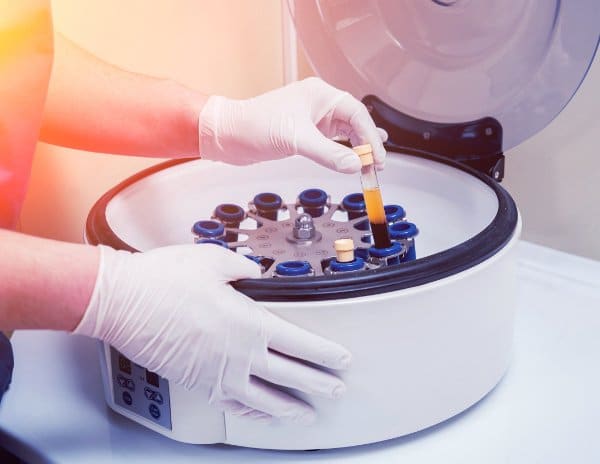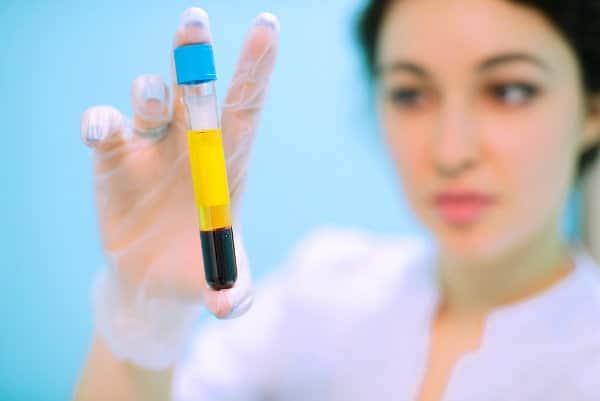PRP Labs is an authorized distributor of EmCyte PRP Kits. Therefore, the contents of this page are an advertisement. We strive to be objective and transparent.
The increasing popularity of orthobiologics, such as platelet rich plasma (PRP) injections, has prompted physicians in many fields to incorporate PRP into their practice. The research is in, PRP facilitates expedited recovery for a wide variety of conditions, such as knee and hip osteoarthritis and surgical wound healing. In the aesthetic space, PRP helps reduce the appearance of acne scars and fine lines. It’s vital for physicians and patients to understand the key differences between the various kits and how PRP protocols effect the final serum. This article looks at some of the key differences between the EmCyte PurePRP and Harvest PRP kits.
Analysis of Commercial PRP Kits
Third party analysis was conducted by Robert Mandle, PhD, who lead a team at BioSciences Research Associates (BSR) in 2015 to compare growth factor release and platelet concentration amongst a selection of commercially available PRP kits.¹ BSR is an independent contract research laboratory located in Cambridge and once academically affiliated with Harvard Medical School. BSR is currently affiliated with the Immune Disease Institute at Harvard and as such draws from a community of nearly 400 bioscience researchers. The BSR laboratory complies with the Food and Drug Administration’s (FDA) Current Good Manufacturing Practice (cGMP) to assist pharmaceutical and biotech companies in product development and clinical trial support.
Interested in Purchasing EmCyte Equipment? Click Here to Learn More
This study compared platelet concentration and growth factor release between 3 different PRP kits:
- Emcyte PurePRP® II 2015 system
- Harvest/Terumo Clear PRP device
- Arthrex Angel system
The researchers drew approximately 160 ml of blood from 7 healthy donors. Each whole blood sample was distributed across platforms in a paired sample design; each donor was tested on all three platforms. Researchers analyzed platelet concentration factor, platelet yield, pH, mononucleated cell counts and growth factor performance. Donors met the requirements of both the American Association of Blood Banks (AABB) and the Food and Drug Administration’s Center for Biologics Evaluation and Research (FDA CBER). Samples were referenced with code numbers; age, sex and ethnicity were not tracked.
Differences in Platelet Recovery Rate

The fundamental difference between the Emctye and Harvest PRP kits is platelet recovery rate. Emcyte PRP kits recover 81% of platelets versus Harvest PRP kits, which only recovery 62% of platelets. In practical terms, this discrepancy in platelet recovery rates allow EmCyte kits to produce PRP with platelet concentration levels about 7 times above blood baselines, while Harvest kits will produce PRP with platelet concentration levels roughly 5 times above blood baselines. One can speculate that differences in platelet recovery rate are inextricable from kit and centrifuge design, but these numbers are also influenced by the use of anticoagulants.
Differences Between Anticoagulants
An anticoagulant is necessary in the preparation of PRP. If no anticoagulant is used, a blood clot will form and the resulting serum will have platelet concentrations no higher than whole blood. Thus blood is collected in the presence of an anticoagulant, which serves to keep platelets from activating during the mechanical force of centrifugation. The Emcyte Pure PRP kit utilizes 10 ml of sodium citrate (SC) per 50 ml of whole blood, while the Harvest Clear PRP system relies on 6 ml of anticoagulant citrate dextrose solution A (ACD-A).
Researchers in Brazil (2016) investigated the influence of various anticoagulants on PRP platelet recovery rates.² The study design compared the effects of various anticoagulants, including SC, ethylenediaminetetraacetic acid (EDTA), and ACD-A. SC, utilized in Emcyte kits, produced PRP with the highest platelet recovery rate at 81.21% followed by EDTA and then ACD-A. Platelet recovery from ACD-A, as found in Harvest kits, were 45.71% almost half that of SC.
Platelet recovery rates dictate the potency of the final PRP serum, which directly affects patient outcomes. Results from this study suggest that differences in platelet recovery rate between the EmCyte PurePRP kit and the Harvest Clear system could be influenced by anticoagulant choice.
Leukocytes in PRP Preparations

BioSciences Research Associates found a significant difference in leukocyte retention between the Harvest PRP kit and EmCyte PurePRP system. The EmCtye PRP contained on average 70% of initial leukocytes, while the Harvest system recovered an average of 7% of leukocytes. Complete blood counts were performed using a hematology analyzer for start sample and final recovery rates. This significant difference in mononucleated cell retention comes down to fundamental differences in kit design.
Leukocytes or white blood cells include specialized cells such as macrophages, neutrophils, and lymphocytes, among others. Leukocyte participation in the wound healing cascade is multifaceted. In general, the literature suggests that leukocyte retention is especially helpful when using PRP to treating open wounds, but aggravates inflammation and slows healing in osteoarthritis. Though it’s important to understand the distinct role of each leukocyte.
Macrophages release collagenase and transforming growth factor which modulate inflammation and encourage tissue regeneration³ and lymphocytes increase tissue remodeling.⁴ As an extension of the immune system, neutrophils have antimicrobial properties which prevent infection. Neutrophils form a protective barrier and improve patient outcomes when treating open wounds, but researchers at Stanford found significantly increased synoviocyte death when cultured synoviocytes were treated with PRP preparations containing neutrophils.⁵ Neutrophils increase proinflammatory mediators and the destruction of the extracellular matrix, which has detrimental effect in cases of osteoarthritis.
The EmCyte Pure PRP system includes protocols for neutrophil-poor and neutrophil-rich PRP. As mentioned, the BSR study found the EmCyte Pure PRP kit retained 70% of mononucleated cells, the presence of neutrophils is at the clinician’s discretion.
pH and Platelet Activation in PRP
Researchers found little difference in pH between the EmCyte Pure PRP and the Harvest PRP kits, 6.9 and 7.0 respectively. The final serum was tested with a blood gas analyzer according to SOP: TM-018 Blood pH. Though this small difference in pH will have little influence on patient outcomes, PRP activators such as calcium chloride are known to significantly affect pH and pain at the injection site.
Basic Chemistry of Platelet Activation

In some situations, physicians rely on collagen at the injection site to slowly activate PRP, while other situations such as surgical wound healing and PRP for tendinopathy benefit from activators such as 10% calcium chloride which leads to rapid growth factor expression as well as a drop in pH.⁶
In both cases the presence of calcium mediates the platelet activation response. According to Cambridge researchers, collagen activates platelets in situ by initiating a chemical response from phospholipase Cy2 to isolate inositol trisphosphate from phosphatidylinositol 4,5-bisphosphate (PIP₂), a lipid component of cell membranes.
Inositol trisphosphate triggers the release of calcium from the dense tubular system, an internal platelet structure. Calcium (together with diacylglycerol) mediate the secretion of growth factors, platelet aggregation, and platelet shape change. When calcium chloride is added for activation, the presence of calcium as well as a drop in pH contribute to platelet degranulation and growth factor expression.
Variation in pH Influences Platelet Activation
Researchers in Sweden investigated the influence of pH on in vitro platelet concentrates with respect to the release of growth factors and cell proliferation in osteoblast-like cells.⁷ Platelet-derived growth factor and transforming growth factor-β were assessed with immunosorbent assays and cell proliferation was assessed with the MTT kit. Platelet concentrates were incubated in buffers at various pH (4.4, 5.4, 7.4, 7.6). The researchers found that platelets incubated in an acidic environment (5.4 pH) induced higher cell proliferation compared to the neutral or alkaline pH.
pH and Patient Comfort

Injecting a substance with a pH lower than the human body, such as CaCl activated PRP, could cause a stinging/burning sensation. To mitigate this burning sensation some providers use a buffer such as 8.4% sodium bicarbonate solution added as ~5% of the final volume of the PRP solution.
There are many nuanced factors to consider when selecting a commercial PRP kit manufacturer. Patient outcomes are influenced by platelet concentration, leukocyte and neutrophil retention, PRP activation protocols, and final pH of the injectate.
Without the influence of a final stage activators such as calcium chloride, the two kits produce PRP with similar pH values, according to third party research. EmCyte kits retain a higher percentage of platelets (81% or 62% respectively), which translates to platelet concentrations of 7x or 5x baseline levels respectively. The EmCyte Pure PRP kit retains 70% of mononucleated cells and comes with protocols that reduce 98% neutrophils. The Harvest PRP kit retains only 7% of mononucleated cells and as such fails to benefit from the healing properties of various leukocytes.
- Mandel R. Report 515 Research Study: Comparisons of Emcyte Pure PRP II 2015, Harvest/Terumo APC60/Clear PRP, and Arthrex Angel PRP Products. Biosciences Research Associates. 2016; June 2015.[pdf]
- DCorrêa do Amaral R, Pereira da Silva N, Haddad N, Lopes L, Ferreira F, Filho R, Cappelletti P, Mello W, Cordeiro-Spinetti E, and Balduino A. Platelet-rich plasma obtained with different anticoagulants and their effect on platelet numbers and mesenchymal stromal cells behavior in vitro. Stem Cells International. 2016; Article ID 7414036, 11 pages.[ncbi]
- Leibovich, SJ, Ross R. The role of the macrophage in wound repair. A study with hydrocortisone and anti-macrophage serum. Am. J. Pathol. 1975;78(1), 71-100.[ncbi]
- Gordon J, Ley SC, Melamed MD, English LS, Hughes-Jones NC. Immortalized B lymphocytes produce B-cell growth factor. Nature. 1984;310(5973), 145-147.[nature]
- Braun HJ, Kim HJ, Chu CR, Dragoo JL. The effect of platelet-rich plasma formulations and blood products on human synoviocytes: implications for intra-articular injury and therapy. The American journal of sports medicine. 2014;42(5):1204-1210. doi:10.1177/0363546514525593.[ncbi]
- Cavallo C, Roffi A, Grigolo B, et al. Platelet-rich plasma: the choice of activation method affects the release of bioactive molecules. BioMed Research International. 2016; Article ID 6591717, 7 pages.[hindawi]
- Wahlström O, Linder C, Kalé A, Magnusson P. Variation of pH in lysed platelet concentrates influence proliferation and alkaline phosphatase activity in human osteoblast-like cells. Platelets. 2007;18(2)113-8.[ncbi]

Get an Instant Quote:
*We Typically Call Within 15 Minutes!





